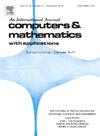流函数形式的二维纳维-斯托克斯方程混合虚拟元素法
IF 2.9
2区 数学
Q1 MATHEMATICS, APPLIED
引用次数: 0
摘要
本研究针对流函数形式的二维静态不可压缩纳维-斯托克斯(Navier-Stokes,NS)方程,提出了一种符合 H1 的混合虚拟元素法(VEM),并对其进行了分析。通过将速度场表示为流函数的卷曲,我们将二阶 NS 系统重塑为标量流函数的四阶非线性方程,从本质上满足了不可压缩性约束。引入涡度变量可为流函数和涡度构建符合 H1 的 VEM 空间,并规避严格的 C1 连续性约束。所提出的方法初步探索了使用任意阶灵活 VEM 在一般多边形网格上进行流函数-涡度离散的方法。在小数据假设下,离散解的存在性和唯一性从理论上得以确立。然后,在流函数的能量规范、流函数的 H1- 规范和涡度的 L2- 规范中导出了最佳误差估计,并严格证明了收敛性。数值结果验证了误差分析,并说明了混合 VEM 在模拟复杂几何形状上不可压缩流动时的准确性和稳健性。本文章由计算机程序翻译,如有差异,请以英文原文为准。
A mixed virtual element method for the two-dimensional Navier-Stokes equations in stream-function formulation
This work presents the formulation and analysis of a conforming mixed virtual element method (VEM) for the two-dimensional stationary incompressible Navier-Stokes (NS) equations in stream-function formulation. By representing the velocity field as the curl of a stream function, we recast the second-order NS system into a fourth-order nonlinear equation for the scalar stream function, inherently satisfying the incompressibility constraint. Introducing a vorticity variable enables construction of conforming VEM spaces for both stream function and vorticity and circumventing stringent continuity constraints. The proposed method provides an initial exploration of stream function-vorticity discretizations on general polygonal meshes using the flexible VEM of arbitrary order. Existence and uniqueness of discrete solutions are established theoretically under a small data assumption. Optimal error estimates are then derived in the energy norm for the stream function, norm for the stream function and norm for the vorticity, rigorously demonstrating convergence. Numerical results validate the error analysis and illustrate the accuracy and robustness of the mixed VEM for simulation of incompressible flows on complex geometries.
求助全文
通过发布文献求助,成功后即可免费获取论文全文。
去求助
来源期刊

Computers & Mathematics with Applications
工程技术-计算机:跨学科应用
CiteScore
5.10
自引率
10.30%
发文量
396
审稿时长
9.9 weeks
期刊介绍:
Computers & Mathematics with Applications provides a medium of exchange for those engaged in fields contributing to building successful simulations for science and engineering using Partial Differential Equations (PDEs).
 求助内容:
求助内容: 应助结果提醒方式:
应助结果提醒方式:


